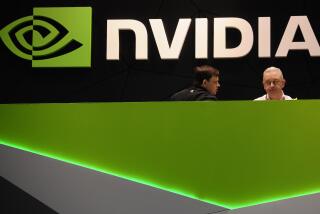Chip Makers Try to Score With Gamers
- Share via
When the going gets tough, the tough play games.
With the semiconductor industry in the doldrums, chip makers Intel Corp. and Advanced Micro Devices Inc. are coaxing game developers to churn out bigger, faster games to give consumers a reason to run out and buy new computers.
Intel and AMD always have helped software developers create programs that can soak up microprocessor power, but they recently have picked up the pace with game geeks. The reason: U.S. chip sales stumbled 44% in 2001, while sales of computer games grew 4% to $1.42 billion.
“Chip companies are trying to exploit every reason they can think of to persuade people to upgrade, and PC games are a great big reason for a lot of consumers,” said Steve Koenig, an analyst with market research firm NPD Intelect.
Intel in particular has become far more aggressive in the last few months. The Santa Clara, Calif.-based chip company paid more than $1 million, a record, to have its logo placed in an upcoming game from Electronic Arts Inc. called “The Sims Online.” It also launched several print advertising campaigns aimed squarely at gamers, ramped up its sponsorship of game industry events and significantly expanded its budget for joint marketing efforts with game publishers.
Not to be outdone, AMD has devoted a team of four programmers to keep close tabs on game developers.
“We don’t cater to gamers,” said Mark de Frere, a marketing manager for AMD in Sunnyvale, Calif. “We pander to them.”
The chip companies say they are happy with the results.
“We wanted to understand gamers a little better, build and cultivate a relationship with them, and hope they’ll recommend us to their friends and families,” said Brian Favel, Intel’s marketing manager for consumer desktops. “Thus far, we’ve been extremely happy with the results. We’re getting more people in the gaming industry coming to us looking for partnerships, and we’re getting a lot of positive comments on enthusiast Web sites. We’re really trying to take the time to listen and understand what they need.”
Why all this attention?
Office applications such as spreadsheets and word processors have plateaued in their requirements for additional central-processing-unit--or CPU--horsepower, but games continue to advance in their hunger for speed.
“Once we got into the 400-megahertz range, most Microsoft Office users got all the power they needed,” said Peter Glaskowsky, editor of Microprocessor Report, an industry newsletter. “But games can use up all your CPU power, and they always will be able to.
“If game developers suddenly got 10 times the power, they can instantly use it up just by adding 10 times more monsters in the game,” Glaskowsky said. “But games have also been making the monsters smarter so they don’t just stand there when you shoot at them. They duck and lure you. It’s called artificial intelligence, and it’s something game developers have been adding incrementally over time to take advantage of the processing power.”
Take “EverQuest,” an online game produced by Sony Online Entertainment. When the title debuted 3 1/2 years ago, it needed a 166-MHz Pentium-class processor and 32 megabytes of random access memory, or RAM. For the latest title due out next month, “EverQuest: Planes of Power,” Sony will recommend an 800-MHz Pentium III processor and 512mb of RAM.
“What we’ve done is drive customers to upgrade their systems to play the game,” said Scott McDaniel, vice president of marketing for Sony. “So we’ve essentially forced an upgrade path with every product launch.”
*
Grass-Roots Inspiration
Games also played a crucial role in launching the graphics-card market in the mid-1990s. Titles such as “Quake” and “Need for Speed” sparked consumer demand for graphics cards that can render lush environments and deliver fast, smooth game action.
Computer gamers are happy to play along and traditionally are among the first to upgrade their PCs and push the limits of processing power. For years, gamers traded tips on how to “overclock” CPUs by taxing the chips beyond their advertised speeds.
Intel and AMD have long recognized the grass-roots contribution of gamers, not only with their purchasing power but also with their influence over nontechnical buyers who seek their advice. AMD in 1998, for example, worked with Id Software to make a special version of “Quake II” that specifically took advantage of AMD’s chip, an engineering process called optimizing. The title helped seal AMD’s reputation among gamers.
But until recently, such efforts were informal, particularly at Intel.
“In the past, it was much more opportunistic,” said Yves Blehaut, senior vice president of Infogrames Inc., which publishes powerhouse titles such as “Neverwinter Nights,” “Unreal Tournament” and “Civilization III” and is working with Intel. “Now it’s much more coordinated, much more strategic.”
Intel started a program three months ago to place its Pentium 4 chip logo on the back of computer game packaging, something AMD also has done for years. Intel last year also began sponsoring game tournaments such as the Cyberathlete Professional League and the Fragapalooza.
*
Tech Help for Developers
From the game industry’s point of view, chip companies offer two things. The first is marketing resources, such as tournament sponsorships and joint advertising. Intel, for example, paid a large portion of the expenses for a bus that toured national cities trumpeting Sony’s “EverQuest.”
Chip companies also offer technical help. Intel and AMD regularly offer to send engineers to help game developers exploit their chips’ capabilities. The help ranges from answering technical questions over the phone to sitting beside developers writing code. For example, San Francisco-based Discreet, which makes software tools for game developers, sets aside a desk just for Intel engineers.
Some developers decline the hands-on engineering help, especially if it involves substantial changes in the game’s internal code to tailor the game for a particular chip.
John Carmack, who develops the “Doom” and “Quake” game series, said he turned down several such offers. Aside from taking advantage of a CPU’s added speed, optimizing a game, as the practice is called, doesn’t yield enough of a performance kick to be worth the effort to maintain the code base over time, Carmack said.
“At most, you’re talking about 10% to 15% increase in performance,” he said. “I just find that in most cases, it’s not worth the effort.”
*
Alex Pham’s recent interview with AMD’s Hector Ruiz is at www.latimes.com/amd.
*
(BEGIN TEXT OF INFOBOX)
The Need for Speed
System requirements for popular games have climbed steadily as developers pack in more features and fancier graphics.
Minimum Recommended
EverQuest
Processor: Pentium 166 Pentium 200
EQ: The Ruins of Kunark
Processor: Pentium 200 Pentium II 266
EQ: The Scars of Velious
Processor: Pentium 200 Pentium II 350
EQ: The Shadows of Luclin
Processor: Pentium II 400 Pentium III
Source: Sony Online Entertainment






